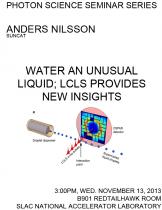Anders Nilsson, SUNCAT
The anomalous physical properties of water are responsible for sustaining much of life on earth; for example, water displays a higher heat capacity than common liquids and expands upon freezing. Some of these anomalous physical properties become dramatically enhanced upon supercooling below the freezing point. In particular, extrapolations of the thermal expansion coefficient, isothermal compressibility, heat capacity and correlation length can all be fitted with a power law divergence with the same apparent singularity temperature of about 228 K. Experiments on pure bulk water below about ~240 K have so far been difficult: water crystallization occurs very rapidly, so far preventing measurements of the liquid phase below the homogeneous nucleation temperatures (TH) of ~232 K leading to a “no-man’s land” devoid of experimental results regarding the structure. Here, we have used LCLS to study the structure of liquid states at supercooled conditions below their limit of homogeneous nucleation by fast evaporative cooling and ultrafast probing down to a temperature of 227K. We can based on the results investigate the various scenarios to explain the anomalous properties of water.





